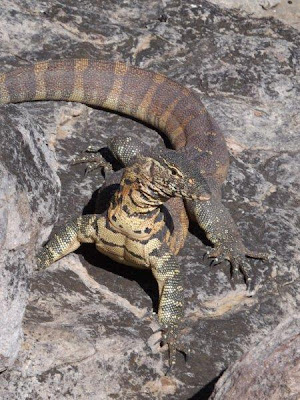It’s a long time since I posted anything to this blog. As well as a long period when we had no internet access, we’ve also been busy with two groups of very helpful French volunteers and have just spent a week in Bulawayo
One of the projects we have been involved with is what we are calling ‘museuming’. This started from the Southern Africa Bird Atlas Project that seeks to collect presence/absence data for bird species in approximately 9km x 9km map squares called Pentads. Why not, we thought, do the same thing but for some of the more overlooked species in the Park and get photos of them as well since, in many cases we would not be able to identify them down to species level. It seemed a good idea so one day when we had been at Chawato for a mammal count, we made a start by spending some time turning over rocks to look for insects, spiders, scorpions, lizards or whatever else was to be seen. That might not sound like a lot of fun but we, and especially Sue, have been absolutely gripped by the whole thing and we find ourselves looking for new specimens wherever we go. Sue has been collecting all the photos and details of where they were found etc into our Sinamatella virtual museum – effectively the beginning of an inventory project for the area. It is obviously a massive task and we know we will get nowhere near a complete inventory but anything we get is more than we have at the moment and at a time of rapid environmental change it is potentially valuable (as well as fun!)
At this time of year there are few insects to be seen but even so, insects and arachnids have made up most of the specimens so far. Some of the small creatures are quite spectacular when they are photographed close to. This is a jumping spider, family Salticidae
It’s only about 7 mm long but must be a formidable sight to its prey.
Another spectacular-looking spider is this Wolf Spider (Lycosid) which Sue found at the entrance to its nest under a rock near Baobab Pan. .
It’s a strange creature at normal magnification but its ‘face’, enlarged, is frankly weird.
Along with the spiders, we’ve found quite a few scorpions. The nastiest looking, like this big Rock Scorpion are supposedly the least dangerous and certainly this one made no attempt to do anything aggressive when we found it at the Gurangwenya River while we were setting a camera trap.
Sue has photographed quite a few creatures that we previously knew very little about. She has found several species of ‘Fish moth’ which are neither fish nor moths and would normally be completely overlooked but they are actually quite attractive….
This one is a Lepismatid, with a body about 15.mm long and those long antennae at one end and cerci.at the other make up a further 40mm or more. Sue found it under a piece of dead Mopane wood while I was helping some tourists whose car had a puncture – no chance missed to ‘collect’ a new specimen!
As well as the ‘creepy-crawlies’ we’ve also added some reptiles and a few mammals to the museum. I love this photo of a large Water Monitor we found at Mandavu Dam, looking towards the camera….
And this is one of our few mammals, a horseshoe bat found inside a huge, hollow Baobab near the Mbala river.
There were three or four of them in the tree but they were very difficult to photograph so I climbed inside for a closer look whereupon this one flew out and perched beneath a branch where we were able to see it and photograph it clearly. We’re hoping to add some snakes to the museum now the warmer weather is coming and they are starting to move around but if we find a snake in a hollow tree I won’t be climbing in for a closer look – even in the interests of science.







Would you add this and any other bat photos as a citizen-science observations to the AfriBats project on iNaturalist?:
ReplyDeletehttp://www.inaturalist.org/projects/afribats
AfriBats will use your observations to better understand bat distributions and help protect bats in Africa.
Please locate your picture on the map as precisely as possible to maximise the scientific value of your records.
Many thanks!